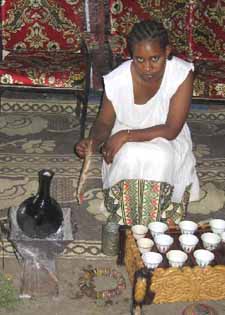
Ethiopia’s coffee ceremony is an integral part of their social and cultural life. An invitation to attend a coffee ceremony is considered a mark of friendship or respect and is an excellent example of Ethiopian hospitality. Performing the ceremony is almost obligatory in the presence of a visitor, whatever the time of day. Don’t be in a hurry though – this special ceremony can take a few hours. So sit back and enjoy because it is most definitely not instant.
The ceremony is usually conducted by one young woman, dressed in the traditional Ethiopian costume of a white dress with coloured woven borders. The long involved process starts with the ceremonial apparatus being arranged upon a bed of long scented grasses. The roasting of the coffee beans is done in a flat pan over a tiny charcoal stove, the pungent smell mingling with the heady scent of incense that is always burned during the ceremony. The lady who is conducting the ceremony gently washes a handful of coffee beans on the heated pan, then stirs and shakes the husks away.
When the coffee beans have turned black and shining and the aromatic oil is coaxed out of them, they are ground by a pestle and a long handled mortar. The ground coffee is slowly stirred into the black clay coffee pot locally known as ‘jebena‘, which is round at the bottom with a straw lid. Due to the archaic method used by Ethiopians, the ground result can be called anything but even, so the coffee is strained through a fine sieve several times. The youngest child is then sent out to announce when it is to be served and stands ready to bring a cup of coffee first to the eldest in the room and then to the others, connecting all the generations.
The lady finally serves the coffee in tiny china cups to her family, friends and neighbours who have waited and watched the procedure for the past half-hour. Gracefully pouring a thin golden stream of coffee into each little cup from a height of one foot without an interruption requires years of practice.
Originally posted on June 10, 2006 @ 4:39 am